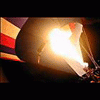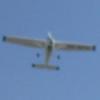Most Bizzare Method To Save Fuel Consumption!
#1
Posted 25 August 2010 - 12:16 PM
All of you are probably expert in fuel savings for your planes. Many common methods to save aviation fuel include economical cruising speed, very careful and controlled climbing after take off, taxiing to runway from gate with one engine instead of two or so on, using sophisticated computer methods (FMC) and other usual methods.
NOW GET THIS
Here is new method that will make all of you understand why all virtual airlines love to have fly together events to save fuel:
A group of researchers at Stanford University, led by Ilan Kroo, has suggested
that airlines could take a more naturalistic approach to
cutting jet-fuel use. The answer, says Kroo, lies with birds.
Scientists have long known that birds flying in formation
expend less energy. The air flowing over a bird's wings
curls upward behind the wingtips, a phenomenon known as
upwash. Other birds flying in the upwash experience reduced
drag and thus spend less energy propelling themselves. Aeronautics
expert Peter Lissaman has suggested that a formation
of 25 birds might enjoy a range increase of 71 percent.
The principles are not substantially different when applied
to aircraft. Kroo and his team modeled what would
happen if three passenger jets departing from Los Angeles, San
Francisco, and Las Vegas were to rendezvous over Utah, assume
an inverted V-formation, occasionally swap places so all
could have a turn in the most-favorable positions, and proceed
to London. They found that the aircraft consumed as much
as 15 percent less fuel, with a concomitant reduction in CO2
output. Nitrogen-oxide emissions during the cruising portions
of the flight fell by around 25 percent.
Regards,
Aharon
#2
Posted 25 August 2010 - 12:24 PM
#3
Posted 25 August 2010 - 12:52 PM
#4
Posted 25 August 2010 - 12:52 PM
#5
Posted 25 August 2010 - 12:54 PM
That just isn't applicable for air transport aircraft, for a multitude of reasons.
#6
Posted 25 August 2010 - 01:25 PM
#7
Posted 25 August 2010 - 01:26 PM
 THBatMan8, on Aug 25 2010, 12:52 PM, said:
THBatMan8, on Aug 25 2010, 12:52 PM, said:
I don't think they have to worry about that.
Notice the opening pass...extremely slow speed and one 737 juuuuust behind the other. And it didn't stall!
#8
Posted 25 August 2010 - 01:33 PM
#9
Posted 25 August 2010 - 02:32 PM
 Yay4Afterburners, on Aug 25 2010, 02:26 PM, said:
Yay4Afterburners, on Aug 25 2010, 02:26 PM, said:
Notice the opening pass...extremely slow speed and one 737 juuuuust behind the other. And it didn't stall!
A stall can happen at any speed, and distorted air increases the chances of stalling. It's the physics of flight that are the reason behind IFR separation minimums.
#10
Posted 25 August 2010 - 02:34 PM
#11
Posted 25 August 2010 - 02:38 PM
 Yay4Afterburners, on Aug 25 2010, 03:34 PM, said:
Yay4Afterburners, on Aug 25 2010, 03:34 PM, said:
It's called wake turbulence, as I mentioned before. The larger the aircraft, the more wake turbulence it leaves behind. You rarely hear about formation flying causing stalls because aircraft of the same mass are usually in formation. Put a Cessna 172 in a formation behind a 747 and the Cessna pilot will struggle to hold a altitude.
I also never said that stalls are immanent in formation flying either. I said the wake turbulence increases the chances of a stall happening, because the airflow over the wing is distorted.
Edited by THBatMan8, 25 August 2010 - 02:39 PM.
#12
Posted 25 August 2010 - 02:42 PM
 THBatMan8, on Aug 25 2010, 02:38 PM, said:
THBatMan8, on Aug 25 2010, 02:38 PM, said:
I also never said that stalls are immanent in formation flying either. I said the wake turbulence increases the chances of a stall happening, because the airflow over the wing is distorted.
Ummm...are you familiar with mid-air refueling? Small fighter flying right behind and through the wake of a large tanker aircraft?
#13
Posted 25 August 2010 - 02:44 PM
 Yay4Afterburners, on Aug 25 2010, 03:42 PM, said:
Yay4Afterburners, on Aug 25 2010, 03:42 PM, said:
No, I never heard of that.
Again, I never said that stalls are immanent, only the chances of a stall increase because the airflow over the wing is disorted.
#14
Posted 25 August 2010 - 02:49 PM
 THBatMan8, on Aug 25 2010, 02:44 PM, said:
THBatMan8, on Aug 25 2010, 02:44 PM, said:
Again, I never said that stalls are immanent, only the chances of a stall increase because the airflow over the wing is disorted.
But obviously so small it's not even a real concern...
By the way, in you cessna flying with a 747 thing....forget the altitude, how would it keep up with a jet going 600 mph at 30,000 feet?
#15
Posted 25 August 2010 - 02:52 PM
 Yay4Afterburners, on Aug 25 2010, 03:49 PM, said:
Yay4Afterburners, on Aug 25 2010, 03:49 PM, said:
By the way, in you cessna flying with a 747 thing....forget the altitude, how would it keep up with a jet going 600 mph at 30,000 feet?
Who said anything about the 747 going 600mph at 30,000'? 747's and Cessna's fly together all the time while approaching and departing major airports. Stalling is never a small concern either. You should never intentionally jeopardize the safety of the aircraft and it's passengers to save fuel.
#16
Posted 25 August 2010 - 02:54 PM
 THBatMan8, on Aug 25 2010, 02:52 PM, said:
THBatMan8, on Aug 25 2010, 02:52 PM, said:
I don't think that's relevant to airliners flying a simple formation during cruise.
#17
Posted 25 August 2010 - 02:57 PM
 Yay4Afterburners, on Aug 25 2010, 03:54 PM, said:
Yay4Afterburners, on Aug 25 2010, 03:54 PM, said:
How is it not relevant? There are too many risks involved with close-nit airliner formation flying, which outweigh the benefits of saving fuel. If you think otherwise, then try to convince the FAA/NTSB.
#18
Posted 25 August 2010 - 02:58 PM
 THBatMan8, on Aug 25 2010, 02:57 PM, said:
THBatMan8, on Aug 25 2010, 02:57 PM, said:
What risks? You have trained pilots flying planes of the same mass together...it's not any different than a formation of fighters or bombers, just on a different scale...
#19
Posted 25 August 2010 - 03:02 PM
 Yay4Afterburners, on Aug 25 2010, 03:58 PM, said:
Yay4Afterburners, on Aug 25 2010, 03:58 PM, said:
Lets see,
1) Formation flight enters a storm, one plane gets knocked off course and collides with another plane.
2) One aircraft stalls, and collides with another plane
3) One aircraft suffers a navigation failure, and collides with another plane
I can go on and on. No one really cares when 2 F-15's crash, but when 2 747's carrying 500ish people each crash doing the same thing, all
#20
Posted 25 August 2010 - 03:08 PM
 THBatMan8, on Aug 25 2010, 03:02 PM, said:
THBatMan8, on Aug 25 2010, 03:02 PM, said:
1) Formation flight enters a storm, one plane gets knocked off course and collides with another plane.
2) One aircraft stalls, and collides with another plane
3) One aircraft suffers a navigation failure, and collides with another plane
I can go on and on. No one really cares when 2 F-15's crash, but when 2 747's carrying 500ish people each crash doing the same thing, all
1, 2, and 3.) That's why you have spacing both horizontal and vertical, maintain a good visual on the lead plane, and be ready to break formation at any time. The reverse V is actually a brilliant formation, too, since you have a pilot in the slot who can see all the other planes at all times, acting as a safety.
And you are an idiot if you think no one cares with two F-15s crash. Their families, friends, and neighbors care, plus that's about $80 million dollars of your money and mine going up in flames, so the tax payers and DoD also cares.




















